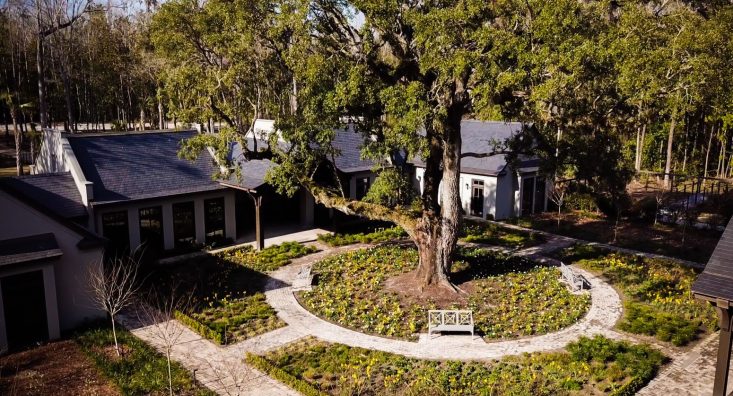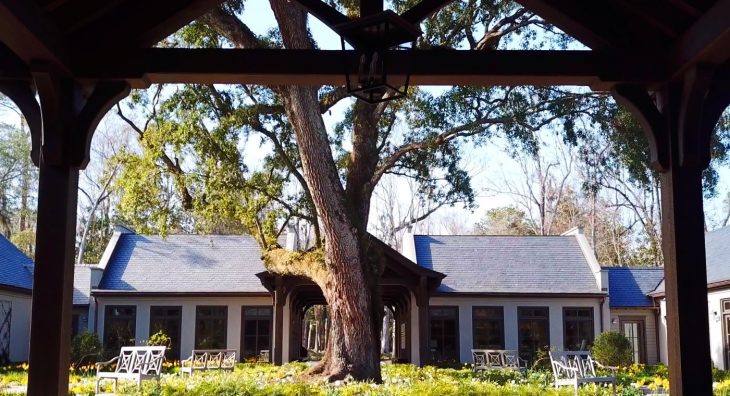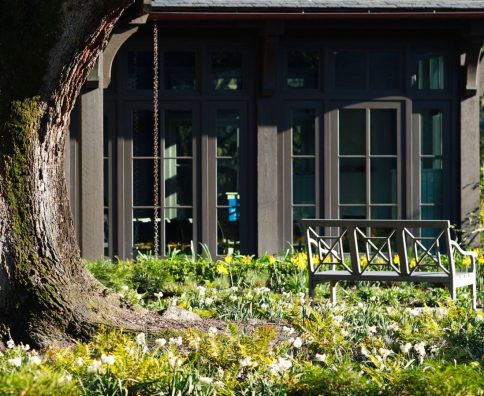Voted the Best Place to See by Condé Nast Traveler.


Nearly one year ago the Sally Reahard Visitors Center opened at Drayton Hall along with the Lenhardt Garden which, on its first anniversary, presents a good time to reflect on this evolving, artistic and horticultural endeavor, full of many challenges, successes, and yes, some setbacks. In January 2018, as the planting of the very large, and freshly dug, Bracken’s Brown Beauty magnolias and Natchez Crepe Myrtle arrived for planting, the Charleston area was plunged into a week of ice, snow and sub-twenty temperatures. As the plants had barely been set in the ground and the snow and temperatures dropped, it was to be several months before the slow effects of such cold winter would become apparent. In the meantime, work continued to prepare the soil, install the irrigation and walkways, and locate and order the many other plants for the Garden now scheduled for a grand opening in late April 2018. As the contractors concentrated on planting the large sasanqua camellias, sweet-bay magnolias, viburnums, hollies, palms and African irises, and oakleaf hydrangea. Concurrently, Drayton Hall staff and volunteers worked daily to install plantings in the Lenhardt Courtyard, the living heart of the new Garden. From late February to early April nearly 1000, one-gallon containers of bee balm, Virginia iris, Stokes asters, great blue lobelia, woodland phlox, blue-eyed grass, azure salvia, and clary sage would be planted within the four, boxwood bordered quadrants of the Courtyard. Also arranged in the quadrants were 24 Champney’s Pink Cluster roses trained on custom made cedar-wood hoops to increasing the number of amazingly fragrant sprays of light pink flower clusters, still blooming into this current winter. Additionally, added to these plantings were 32 pink Muhlenbergia, sweet grass, and 4 large Camellia sinensis, tea would be installed along with 300 pink and lavender digitalis, 180 Verbena bonariensis, and 500 Narcissus ‘Soleil d’or’ would be planted to fill and unite these quadrants. And finally, in the center of the Courtyard under a grand oak, over a thousand Christmas and autumn ferns would be set into the ground. By mid-April with all planted, and looking nearly perfect, the digitalis, Narcissus, phlox, blue-eyed grass welcomed the first visitors, during the grand opening of the Center and the Lenhardt Garden.

All seemed great, but then spring moved on to summer and then the heat and heavy rains began, and never ended. This quickly had negative, and surprising effects on many of the new plants. Verbena bonariensis, which many consider an invasive, but honestly pretty weed, contracted powdery mildew and rotted in the soil. Similar effects occurred to the salvia and, along with the heat, the clary sage quickly diminished. The first round of tea camellia shrubs all rotted in the ground, as well as, the many Narcissus. Not all however was gloom and doom. The pink muhly grass, lobelia, iris, Stokes aster, and even bee balm seemed to thrive. Most outstanding was the Champney’s Pink Cluster rose, which only seemed momentarily effected, and by autumn, the plants had exploded with lush growth and large clusters of flowers. This earliest Noisette rose, discovered in Charleston, has quickly become a favorite of Drayton Hall staff and visitors as well as Mr. Lenhardt. One last, but major setback, remember the freeze in January, that little event had the effect of killing our 20 large Natchez crepe myrtles and contributed to the slow decline of 10, fifteen-foot magnolias. For our grand opening, the crepe myrtles did their job, as the clump shape and lovely bark still looked nice, even though we suspected something was wrong. The good news is, by July we made lemons into lemonade and selected 20 new crepe myrtles but decided to go with an elegant “standard” form. And yes, we replaced the magnolias too with slightly smaller, potted material.

This fall, 6000 various Narcissus and Leucojum bulbs were installed in the Lenhardt Garden and Courtyard, some now outlining two new serpentine beds of variegated jasmine. These bulbs have thrived, and with the recent warm weather, are currently in full bloom, delighting our visitors who have escaped the “polar vortex.” With luck, winter will soon pass, the spring will arrive, and the plants will be ready to face another season of challenges. Plant success and failures are nothing new in the long history of Drayton Hall. In researching the historic plant material, much of which was used in the Lenhardt Garden, it is fitting to end on this entry from Charles Drayton’s diary of July 1, 1791, “Sowed in the garden 118 Olive Stones sent in earth from France by Mr. Jeffersons directions for the S. Carolina Agriculture Society . All failed.”
All of the challenges and changes from where it began to the full bloom magical place that is now, were worth the time and patience to resolve the issues. Drayton Hall’s Lenhardt Garden is a world-class garden and a must see for every visitor to Charleston. Follow our “Visit” tab above to get your tickets to Drayton Hall now.